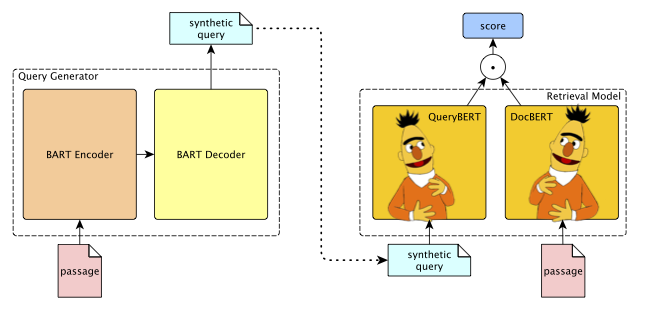Embedding-based Zero-shot Retrieval through Query Generation leverages query synthesis over large corpuses of unlabeled text (such as Wikipedia) to pre-train siamese neural retrieval models. The resulting models significantly improve over previous BM25 baselines as well as state-of-the-art neural methods.
This package provides support for leveraging BART-large for query synthesis as well as code for training and finetuning a transformer based neural retriever. We also provide pre-generated synthetic queries on Wikipedia, and relevant pre-trained models that are obtainable through our download scripts.
Paper: Davis Liang*, Peng Xu*, Siamak Shakeri, Cicero Nogueira dos Santos, Ramesh Nallapati, Zhiheng Huang, Bing Xiang, Embedding-based Zero-shot Retrieval through Query Generation, 2020.
pip install torch torchvision transformers tqdm
python setup.py install --user
| Package | Version |
|---|---|
| torch | >=1.6.0 |
| transformers | >=3.0.2 |
| tqdm | 4.43.0 |
- WikiGQ: We process the Wikipedia 2016 dump and split it into passages of maximum length 100 with respecting the sentence boundaries. We synthesis over 100M synthetic queries using BART-large models. The split passages and synthetic queries files can be downloaded from here.
- Siamese-BERT-base-model: We release our siamese-bert-base-model trained on
WikiGQdataset. The model files can be downloaded from here.
Here we take an example on Natural Questions data. Please download the simplified version of the training set and also use supplied simplify_nq_example function
in simplify_nq_data.py to create the simplified dev set as well.
We provide the python script to convert the data into the format our model consumes.
NQ_DIR=YOUR PATH TO SIMPLIFIED NQ TRAIN AND DEV FILES
python data_processsing/nq_preprocess.py \
--trainfile $NQ_DIR/v1.0-simplified-train.jsonl.gz \
--devfile $NQ_DIR/v1.0-simplified-dev.jsonl.gz \
--passagefile $NQ_DIR/all_passages.jsonl \
--queries_trainfile $NQ_DIR/train_queries.json \
--answers_trainfile $NQ_DIR/train_anwers.json \
--queries_devfile $NQ_DIR/dev_queries.json \
--answers_devfile $NQ_DIR/dev_answers.json \
--qrelsfile $NQ_DIR/all_qrels.txt
OUTPUT_DIR=./output
mkdir -p $OUTPUT_DIR
python examples/neural_retrieval.py \
--query_len 64 \
--passage_len 288 \
--epochs 10 \
--sample_size 0 \
--batch_size 50 \
--embed_size 128 \
--print_iter 200 \
--eval_iter 0 \
--passagefile $NQ_DIR/all_passages.jsonl \
--train_queryfile $NQ_DIR/train_queries.json \
--train_answerfile $NQ_DIR/train_answers.json \
--save_model $OUTPUT_DIR/siamese_model.pt \
--share \
--gpu \
--num_nodes 1 \
--num_gpus 1 \
--train
This will generate two model files in the OUTPUT_DIR: siamese_model.pt.doc and siamese_model.pt.query. They are exactly the same if your add --share during training.
- Passage Embedding
python examples/neural_retrieval.py \
--query_len 64 \
--passage_len 288 \
--embed_size 128 \
--passagefile $NQ_DIR/all_passages.jsonl \
--gpu \
--num_nodes 1 \
--num_gpus 1 \
--local_rank 0 \
--doc_embed \
--doc_embed_file $OUTPUT_DIR/psg_embeds.csv \
--save_model $OUTPUT_DIR/siamese_model.pt
- Running Retrieval
python examples/neural_retrieval.py \
--query_len 64 \
--passage_len 288 \
--batch_size 100 \
--embed_size 128 \
--test_queryfile $NQ_DIR/dev_queries.json \
--gpu \
--num_nodes 1 \
--num_gpus 1 \
--local_rank 0 \
--topk 100 \
--query_embed \
--query_embed_file $OUTPUT_DIR/dev_query_embeds.csv \
--generate_retrieval \
--doc_embed_file $OUTPUT_DIR/psg_embeds.csv \
--save_model $OUTPUT_DIR/siamese_model.pt \
--retrieval_outputfile $OUTPUT_DIR/dev_results.json
- Evaluation
We use trec_eval to do the evaluation.
trec_eval $NQ_DIR/all_qrels.txt $OUTPUT_DIR/dev_results.json.txt -m recall
- Download the BART-large model files from Huggingface model hub here.
- Download the MSMARCO-PR dataset files from the official website: collection.tsv, queries.train.tsv, queries.dev.tsv, qrels.train.tsv, qrels.dev.tsv.
MSMARCO_PATH=YOUR PATH TO MSMARCO FILES
QG_MODEL_OUTPUT=./qg_model_output
mkdir -p $QG_MODEL_OUTPUT
CUDA_VISIBLE_DEVICES=0,1,2,3 python examples/bart_qg.py \
--corpusfile $MSMARCO_PATH/collection.tsv \
--train_queryfile $MSMARCO_PATH/queries.train.tsv \
--train_qrelfile $MSMARCO_PATH/qrels.train.tsv \
--valid_queryfile $MSMARCO_PATH/queries.dev.tsv \
--valid_qrelfile $MSMARCO_PATH/qrels.dev.tsv \
--max_input_len 300 \
--max_output_len 100 \
--epochs 5 \
--lr 3e-5 \
--warmup 0.1 \
--wd 1e-3 \
--batch_size 24 \
--print_iter 100 \
--eval_iter 5000 \
--log ms_log \
--save_model $QG_MODEL_OUTPUT/best_qg.pt \
--gpu
As an example, we generate synthetic queries on NQ passages.
QG_OUTPUT_DIR=./qg_output
mkdir -p $QG_OUTPUT_DIR
python examples/bart_qg.py \
--test_corpusfile $QG_OUTPUT_DIR/all_passages.jsonl \
--test_outputfile $QG_OUTPUT_DIR/generated_questions.txt \
--generated_queriesfile $QG_OUTPUT_DIR/syn_queries.json \
--generated_answersfile $QG_OUTPUT_DIR/syn_answers.json \
--model_path $QG_MODEL_OUTPUT/best_qg_ms.pt \
--test \
--num_beams 5 \
--do_sample \
--num_samples 10 \
--top_p 0.95 \
--gpu
See CONTRIBUTING for more information.
This project is licensed under the Apache-2.0 License.

